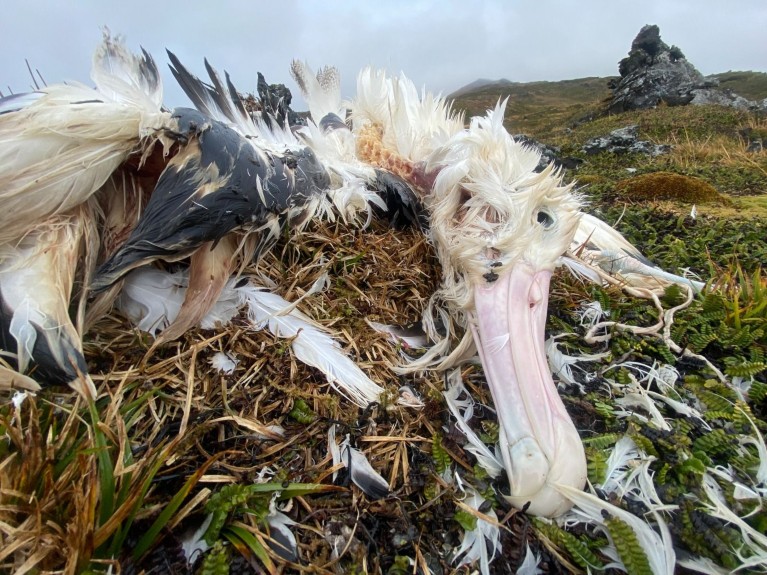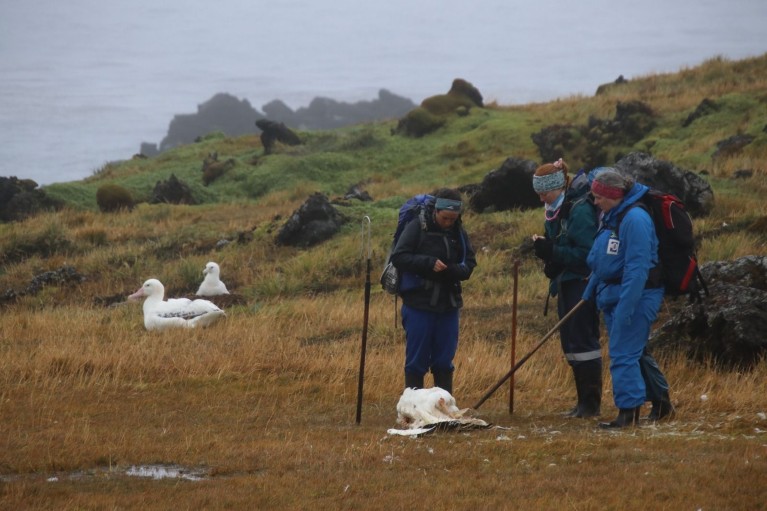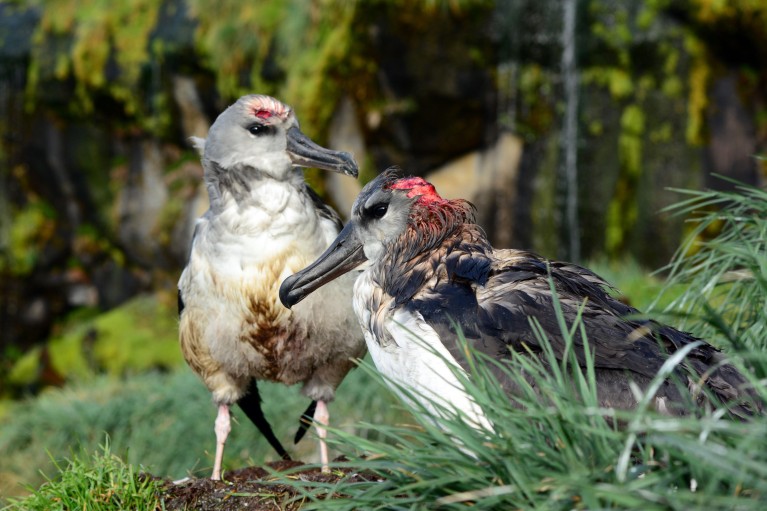
The grim result of a mouse attack.Credit: Anton Wolfaardt
Mice are gnawing on adult wandering albatrosses causing injuries that later lead to their deaths. The discovery in April on Marion Island, in the southern Indian Ocean, where 25% of the global albatross population nests, has raised fears for their future.
Marion Island and Prince Edward Island some 20km away, make up the Prince Edward Islands marine protected area, a South African territory about 2,200 km south-east of Cape Town in the southern Indian Ocean. The Prince Edward Islands are home to half the world’s breeding wandering albatrosses.
Mice arrived on Marion when it was a stop-off point for sealing vessels in the early 1800s. For two centuries, the rodents survived on insects and other invertebrates, mostly a local flightless moth, as well as weevils, mites, spiders, and worms.
Researchers on Marion Island examine an albatross carcass.Credit: Christopher Jones
The bodies of the two wandering albatross adults, fresh enough for evidence of the cause of their death, turned up on the northern coastline of Marion Island in the sub-Antarctic this April. They were among eight adult albatross bodies found in the immediate vicinity. All had died within weeks of each other. The carcasses had deep wounds at the elbows. The surrounding blood pattern indicated the injuries had been inflicted while the birds were still alive. The likely cause of death: secondary infection, or starvation as the crippled birds would have been unable to feed at sea.
“It’s very unusual to find albatross carcasses on land, because these birds spend most of their lives at sea,” says marine ecologist, Maëlle Connan, from the Institute for Coastal and Marine Research at Nelson Mandela University, South Africa.
Connan and her colleagues recognised that the injuries were typical of those inflicted by mice, which are increasingly finding easy prey in nesting seabirds global population.
Young grey headed albatrosses, with scalp injuries from mice attacks.Credit: Ben Dilley
Marion Island has become notably warmer and drier in the past three decades, giving mice a longer summer breeding season, allowing their numbers and food demands to grow exponentially. Researchers estimate that invertebrate numbers have fallen by almost 90% on Marion since the mid-1970s. This is starkly different to neighbouring Prince Edward, which remained mouse-free. Insects are still abundant on Prince Edward, and the plant life is noticeably undamaged by comparison. In 2015, doctoral researcher Ben Dilley with the Percy Fitzpatrick Institute of African Ornithology at the University of Cape Town captured footage of nocturnal mouse attacks on grey-headed albatross chicks on south Marion, confirming a trend that had escalated at an “unprecedented” rate over the previous two decades: When mice find young, down-covered chicks, they attack the birds’ wings or rumps. With older fledglings, whose feathers have toughened, the mice find easier pickings on the chicks’ heads, where the soft crown feathers still give easy access to the skin.
The scalped, weakened chicks are left vulnerable to secondary, often fatal infections, or are easy pickings for predators such as petrels. Even though these first adult albatross fatalities are small in number, this change in mouse behaviour is extremely concerning because of the implications for the bird population, according to Peter Ryan, emeritus professor at the PercyFitzpatrick Institute.
Wandering albatrosses only start breeding at eight to 10 years of age, they only have one chick every two years, and it takes almost 12 months for chicks to grow large enough to fly. Wandering albatrosses may be able to reach 60 but from the age of about 30 their breeding potential drops. “To have a sustainable albatross population, you need to have a high adult survival rate,” Ryan says.
In 2025, the South African Department of Forestry, Fisheries and the Environment plans a rodent eradication programme. From April until August, helicopters flying for the Mouse-Free Marion project will sweep the island, spreading blood-thinning rodent-targeted bait. This is the method used in other similar eradication programmes on sub-Antarctic islands such as South Georgia, Macquarie and Campbell, all of which were successful and allowed heavily impacted seabird colonies to recover. The Mouse-Free Marion initiative will be the biggest of its kind, according to Birdlife South Africa, which will run it on behalf of the South African government.
